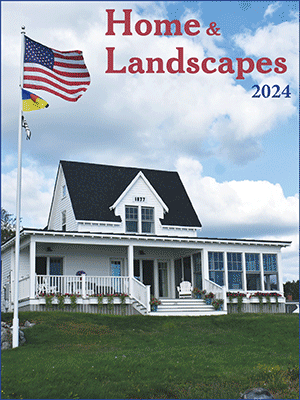Finding the Elusive Golden Eagle
 You will see from this page of photos of different ages of golden eagles from the Crossley ID Guide to Eastern Birds that golden eagles can look a lot like immature bald eagles, which are much more common here in Maine. Check out this field guide or another to learn how to best tell them apart. (Image by Richard Crossley courtesy of Wikimedia Commons.)
You will see from this page of photos of different ages of golden eagles from the Crossley ID Guide to Eastern Birds that golden eagles can look a lot like immature bald eagles, which are much more common here in Maine. Check out this field guide or another to learn how to best tell them apart. (Image by Richard Crossley courtesy of Wikimedia Commons.)
 This photo of a golden eagle from a camera trap at a national park in California shows the kind of images that can be used to identify the eagles and other creatures in the area. (Photo courtesy of U.S. National Park Service.)
This photo of a golden eagle from a camera trap at a national park in California shows the kind of images that can be used to identify the eagles and other creatures in the area. (Photo courtesy of U.S. National Park Service.)
 You will see from this page of photos of different ages of golden eagles from the Crossley ID Guide to Eastern Birds that golden eagles can look a lot like immature bald eagles, which are much more common here in Maine. Check out this field guide or another to learn how to best tell them apart. (Image by Richard Crossley courtesy of Wikimedia Commons.)
You will see from this page of photos of different ages of golden eagles from the Crossley ID Guide to Eastern Birds that golden eagles can look a lot like immature bald eagles, which are much more common here in Maine. Check out this field guide or another to learn how to best tell them apart. (Image by Richard Crossley courtesy of Wikimedia Commons.)
 This photo of a golden eagle from a camera trap at a national park in California shows the kind of images that can be used to identify the eagles and other creatures in the area. (Photo courtesy of U.S. National Park Service.)
This photo of a golden eagle from a camera trap at a national park in California shows the kind of images that can be used to identify the eagles and other creatures in the area. (Photo courtesy of U.S. National Park Service.)
The sighting of a golden eagle has always been a prize for a Maine birder. There are some of these birds in the state every winter but only occasionally is an individual found that is enjoyed by birders over an extended time. Such a bird has been delighting many of those who have traveled up to Knox Ridge (roughly halfway between Waterville and Belfast) to look for it among the many bald eagles hanging out around some farms and composting operations.
Immature bald eagles are often misidentified as golden eagles. Many people are not aware that bald eagles do not reach the adult plumage, with the white head and tail, until four or five years of age. In the intervening years to adulthood they are various versions of brown head, body, wings, and tail with patches of mottled white in the underwings and tail. Golden eagles, are also brown on the head, body, wings, and tail with patches of white in the wings and tail so they look quite similar to an immature bald eagle. Many’s the time that we have been told that a largely brown eagle had to have been a golden eagle because it was so big, perhaps even bigger than a nearby adult bald eagle. Golden eagles are actually about the same size or even a little smaller in appearance than a bald eagle.
Golden eagles nested in Maine, perhaps until the 1990s, but no longer. They actually once nested across New England and New York but have not been documented anywhere in the eastern U.S. since the 1990s. Now, this eastern population of golden eagles (there is an apparently genetically distinct separate population in the western U.S. and Canada) nests only in northern Canada. The total population of eastern golden eagles has been estimated at around 5,000 birds. Here in Maine, the golden eagle is officially on the state endangered species list.
A group of researchers has been trying to learn more about the eastern golden eagle in recent years. One interesting idea that they have been using to find out more about where the birds occur is to place camera traps (otherwise known as game cameras) at places with bait (dead animals). The cameras take a photo whenever something moves in front of it and saves the photos on an SD card. Later, someone can download the photos to a computer and look carefully through them to see what birds (and other animals) come to the bait.
Here in Maine, the Maine Department of Inland Fisheries and Wildlife has started a project to use this baited camera trap technique with the help of volunteers who can set up one of these types of monitoring stations and/or take the time to sort through the many photos that result.
Last year (2024), the study found golden eagles at 22 sites in 20 townships in Maine. Compare that to what birders reported to eBird in Maine in 2024—birds were seen at only three sites! Obviously this baited camera trap technique increases the chances of detecting the relatively few golden eagles that are here.
If you are interested in participating in this fascinating study, contact the Maine Department of Inland Fisheries and Wildlife or go to: https://www.maine.gov/ifw/fish-wildlife/wildlife/species-information/birds/golden-eagle-study.html
Jeffrey V. Wells, Ph.D., is a Fellow of the Cornell Lab of Ornithology and Vice President of Boreal Conservation for National Audubon. Dr. Wells is one of the nation's leading bird experts and conservation biologists. He is a coauthor of the seminal “Birds of Maine” book and author of the “Birder’s Conservation Handbook.” His grandfather, the late John Chase, was a columnist for the Boothbay Register for many years. Allison Childs Wells, formerly of the Cornell Lab of Ornithology, is a senior director at the Natural Resources Council of Maine, a nonprofit membership organization working statewide to protect the nature of Maine. Both are widely published natural history writers and are the authors of the popular books, “Maine’s Favorite Birds” (Tilbury House) and “Birds of Aruba, Bonaire, and Curaçao: A Site and Field Guide,” (Cornell University Press).




































